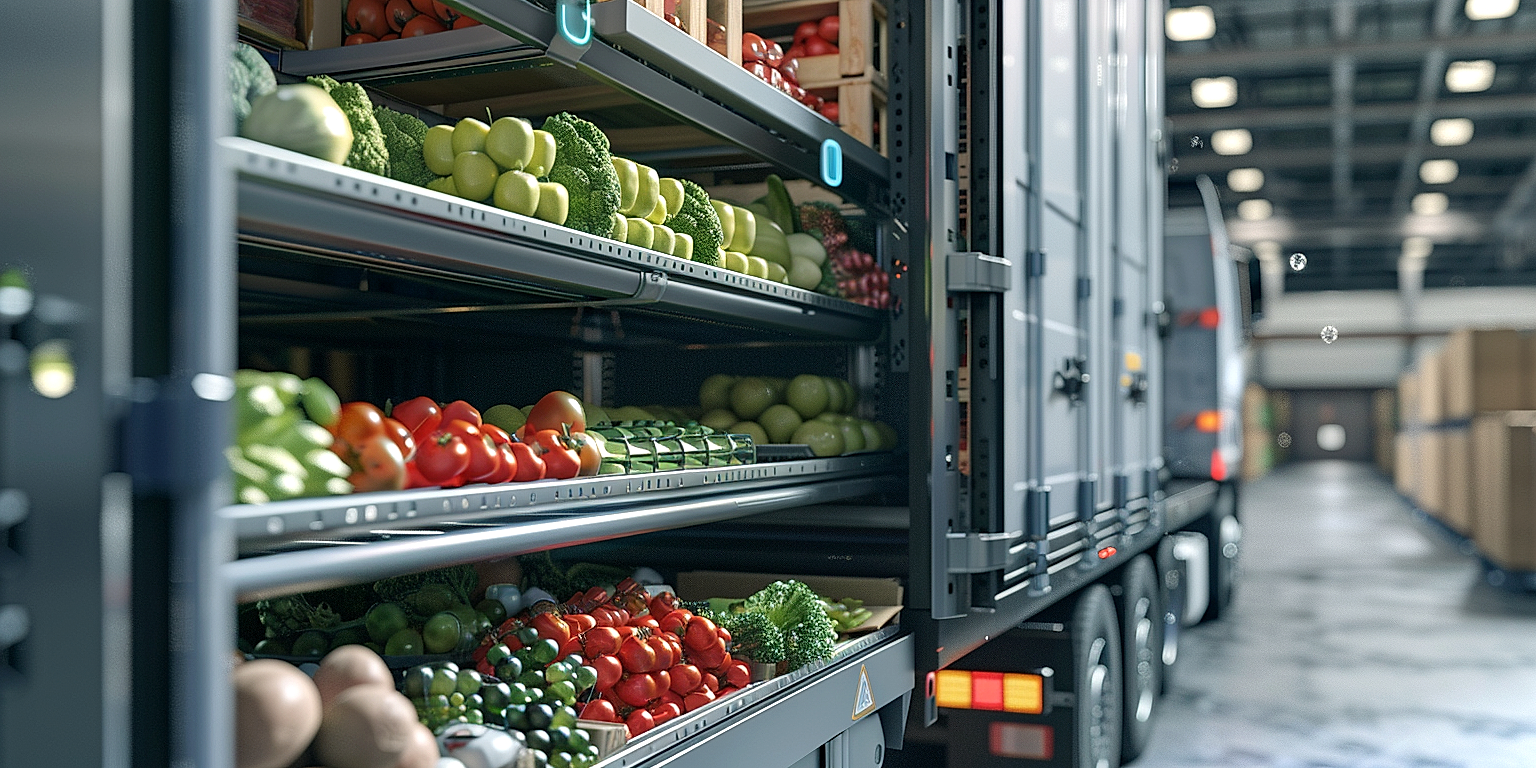In the fast-paced world of the produce shipping industry, efficiency is key.
Without proper logistics planning, businesses in this sector can flounder.
Incidental delays, wastage, and escalating transportation costs are all potential consequences of poor planning efforts.
Ensuring a smooth, unperturbed operational flow requires careful strategizing and robust management.
To maximize profitability and maintain a competitive edge, adopting proven logistics planning practices is essential.
In the following sections, we delve deeper into a set of strategic tips aimed at improving logistics planning in your business.
Contents
- Tips For Effective Logistics Planning In Produce Shipping Business
- 1. Establish a reliable transportation network
- 2. Implement Efficient Inventory Management System
- 3. Prioritize Real-Time Tracking of Shipments
- 4. Automate Logistics Processes When Possible
- 5. Continuously Evaluate Shipping Routes
- 6. Maintain good relationships with carriers.
- 7. Protect produce with appropriate packaging.
- The Bottom Line
Tips For Effective Logistics Planning In Produce Shipping Business
1. Establish a reliable transportation network
Running an efficient produce shipping business requires the establishment of a reliable transportation network.
This involves finding dependable logistics partners that can get the product from the farm to the marketplace safely and swiftly.
Working with reliable carriers who maintain high-quality vehicles and experienced drivers can significantly minimize the risk of shipment disruptions or delays.
As a produce shipper, it’s crucial to recognize that freshness is a key selling point, and any transportation delays can impact the quality of your goods.
Therefore, building a robust transportation network is one of the most significant steps you can take to guarantee product quality and customer satisfaction.
The network should be adaptable to changing supply and demand patterns and capable of absorbing unforeseen shocks like unexpected demand spikes or supply chain disruptions.
As you build this network, you must also ensure it is cost-effective.
High shipping costs can quickly erode profit margins, particularly in a business where products have a short shelf life, like fresh produce. Balancing speed, quality, and cost in transportation is thus critical.
Furthermore, in establishing a reliable transportation network, it’s vital to consider the environmental impact of your operations.
Shippers should actively seek ways to reduce their carbon footprint by choosing more efficient modes of transport or optimizing routes to cut fuel consumption.
The transportation network should also take into account the various regulations and customs that apply to the shipping of produce across borders.
Complying with such regulations is vital to avoid costly delays or legal issues.
Also, keep in mind that establishing a reliable transportation network for a produce shipping business does not happen overnight.
It requires a strategic approach and consistent effort to identify suitable logistics partners, negotiate contracts, and continually monitor performance to ensure standards are met.
The reward for this effort, however, is a smooth-running, successful business able to deliver fresh, high-quality produce to customers on time.
A sophisticated transportation network is a critical component of any successful produce shipping business, and building such a network should be a top priority.
Armed with reliable logistics partners and an efficient transportation network, produce shippers can ensure they deliver the very best products to market, making their business more competitive and giving them an edge over their rivals.
2. Implement Efficient Inventory Management System
Achieving effective logistics planning in the produce shipping business is something that requires an efficient inventory management system
The produce shipping business literally involves perishable goods that require strategic planning and good time management so as not to compromise quality
An efficient inventory management system contributes to the smooth running of the business as it guarantees that products are shipped out while in their best state
The inventory management process involves keeping track of the produce as they move from the farm to the consumers’ tables
A good inventory management system is directly proportional to the success of a logistics plan
An Efficient Logistics plan contributes to reducing wastes, and losses and thus leads to increased revenue.
With an effective inventory management system, you’re able to recover quickly from unexpected events such as a sudden increase in demand or transportation issues
An efficient inventory system allows for flexibility in the business to accommodate these changes in the market
It also involves having a backup plan in case of unavoidable circumstances such as natural disasters which could affect the transportation of the goods
Every produce in stock should be logged into the system with the necessary details, like harvest date, expected shelf life, and storage conditions, to guarantee the freshness of the goods
Without an efficient inventory system, the business may run into various problems like waste of resources, loss of customers, and a decrease in profits
This is because consumers want to receive their goods as fresh as possible, and an efficient inventory management system ensures just that
Furthermore, a good inventory management system will complement other efforts in your logistics plan such as good transportation network and real-time tracking system
With all these benefits, the importance of an efficient inventory system cannot be overemphasized in the produce shipping business
As we all know, everything is gradually being automated, it is advisable to also automate the inventory management system to follow the trend and provide more efficiency
Therefore, businesses must strive to maintain an efficient inventory management system to meet the ever-changing demands of consumers and maintain a competitive edge in the market.
3. Prioritize Real-Time Tracking of Shipments
In the realm of efficient logistics planning in the produce shipping business, it’s crucial to prioritize real-time tracking of shipments .
Doing so facilitates instantaneous updates regarding the location and status of your produce.
This strategy enables businesses to proactively address any issues or delays that might arise during transit.
Through real-time tracking, companies can also ensure optimal freshness of their produce by constantly monitoring its journey.
Incorporating technologies like GPS and RFID tags into their logistics network, businesses can obtain detailed visibility into the whereabouts and condition of their produce shipments.
Real-time tracking in the produce shipping business ultimately means reducing uncertainty, improving service quality, and enhancing supply chain transparency.
Many supply chain management software solutions now offer embedded real-time tracking features, making them indispensable tools for logistics planning in this sector.
With these systems, companies can provide their customers with accurate estimated delivery dates (EDD) and even allow them to trace their produce back to its origin.
Building customer trust in this manner not only helps in customer retention but also sets the business apart in the highly competitive produce shipping industry.
The ability to track shipments in real-time also aids in inventory management .
By having a clear understanding of when shipments are likely to arrive, companies can avoid overstocking or understocking their inventories, thereby reducing waste and improving profitability .
Real-time tracking is also crucial for managing the cold chain, the temperature-controlled supply chain that is critical for maintaining the quality of perishable goods.
With live data on shipments, companies can ensure that their goods are always stored and transported under optimal conditions to retain their freshness.
These benefits of prioritizing real-time tracking do not come without challenges, though.
Businesses must ensure they invest in robust technology and partner with reliable carriers to overcome hurdles like signal interruptions, power outages, or equipment failures.
Despite these challenges, businesses that make real-time tracking of produce shipments a priority can greatly enhance their logistical efficiency and maintain a competitive edge.
4. Automate Logistics Processes When Possible
As a critical element in improving the efficiency and effectiveness of a produce shipping business, automating logistics processes can have a substantial impact.
The implementation of automation in logistics can significantly reduce manual errors, ensuring that orders and shipments are carried out accurately and promptly.
Automation can streamline the entire supply chain, from order placement to delivery.
For instance, an automated inventory management system can provide real-time updates on stock levels, enabling immediate response to potential shortages or overstocks.
Similarly, automated routing systems can optimize delivery routes based on traffic conditions and distances, thereby improving efficiency, saving fuel, and reducing delivery times.
This, in turn, improves customer satisfaction and competitiveness.
Another significant advantage of automation is the potential for cost savings.
By reducing labor-intensive tasks, automation allows company resources to be redirected towards more strategic, revenue-generating activities.
Furthermore, automation can improve the accuracy of forecasting and planning, which is critical in the produce shipping business due to the perishable nature of the products.
By appropriately analyzing data from various sources, automated systems can predict demand patterns and trends, allowing for better planning and decision making.
Companies with highly automated processes can handle larger volumes of orders with greater accuracy and efficiency.
They can also better manage seasonal fluctuations in demand and smoothly accommodate growth and expansion.
Moreover, automation can increase transparency and traceability in the supply chain, enhancing overall control and management.
It allows for effortless tracking of products from the source to their final destination, ensuring that food safety standards are adhered to at all times.
To sum up, while the initial investment in automation might seem considerable, the long-term benefits can be substantial, making it a worthwhile consideration for any produce shipping business.
When properly implemented, automation can pave the way for increased productivity, reduced costs, and greater competitiveness in the dynamic landscape of the produce shipping industry.
5. Continuously Evaluate Shipping Routes
One crucial factor for effective logistics planning in the produce shipping business is the continuous evaluation of shipping routes.
This process involves analyzing the current shipping routes used for transportation and identifying opportunities for efficiency and improvement.
With rising fuel costs and other potential expenses, the effectiveness of shipping routes can have a major impact on overall logistics costs and client satisfaction levels.
Continuously evaluating shipping routes is a proactive strategy that can offer numerous benefits, including cost savings, increased efficiency, and improved customer satisfaction.
It allows your business to mitigate risks associated with delays, unexpected incidents, and unforeseeable disruptions.
In addition, continuous evaluation of shipping routes can also enhance the reliability of your service, strengthening business relationships with clients and partners.
It helps in ensuring that the transportation network remains robust and capable of meeting changing demands.
A key step towards achieving this goal is using logistics software that offer real-time tracking.
These tools provide invaluable data, enabling you to track shipments, assess route efficiency and identify potential bottlenecks or problems in real-time.
Moreover, technologies such as GPS and IoT (Internet of Things) have also made it possible to accurately monitor and control the conditions of each shipment.
However, evaluating shipping routes should not solely depend on modern technology, as it’s equally crucial to consider physical factors such as infrastructure, weather conditions, and local regulations.
Moreover, an experienced logistics planner will also consider timings and contingencies, ensuring that alternative routes and backup plans are in place.
Another part of continuous evaluation is maintaining a balance between speed, cost, and quality of service in determining optimal shipping routes.
Therefore, the process should involve regular consultations with carriers as well as intended recipients of the shipments.
The analysis should be frequent and meticulous, taking into account all relevant factors, thereby enabling the development and fine-tuning of shipping routes for maximum efficiency.
Overall, the practice of continuously evaluating shipping routes is indispensable for effective logistics planning in the produce shipping business.
6. Maintain good relationships with carriers.
As in any business, maintaining strong relationships is integral in a produce shipping business, and the relationship with carriers is particularly crucial.
It’s the carriers who ultimately guarantee the smooth transportation of produce from the farm to its final destination.
They’re the ones who can navigate unforeseen circumstances such as changing weather conditions, new regulations, or unpredictable market demand.
Carriers can often make or break a deal, and it’s a beneficial relationship that deserves much effort and attention.
Establishing a great relationship with your carriers entails understanding their business model, their operational constraints, and their strategic goals.
The more you understand about your carriers, the better you can work together to overcome challenges and find mutual benefits.
Cultivating good relationships with carriers also means communicating frequently and clearly.
Good relationships are built on trust-
Explain your needs, expectations, and potential changes in advance.
That way, your carriers won’t be caught by surprise and can prepare and plan effectively.
In turn, it’s vital that you listen to their needs, suggestions, and concerns.
Remember, they are your partners in business, not just your service providers.
Furthermore, pay them promptly.
Nothing damages a business relationship faster than late payments.
Punctual payment is a clear sign of respect and professionalism.
Lastly, always thank them for their service and show gratitude for their hard work.
Yes, they’re doing their job, but that doesn’t mean their effort should be overlooked.
By maintaining great relationships with carriers, you ensure smooth operations, on-time deliveries, less spoilage, and ultimately the success of your produce shipping business.
7. Protect produce with appropriate packaging.
The role of packaging in the produce shipping business cannot be overemphasized, especially in the context of effective logistics planning.
It’s crucial to understand that packaging is an important pillar of the logistics planning process in the produce shipping business.
Investing in the right type of packaging can not only help maintain the freshness and quality of the produce, but it can also reduce damage and waste during transportation.
Using suitable packaging protects fruits and vegetables from mechanical damage and maintains their quality and safety from the field to the consumer.
Furthermore, packaging ensures ease of handling, stacking, and transport by providing protection to the produce during mechanical actions.
Choosing the correct packing materials such an essential part of logistics planning in the produce shipping business, given its substantial influence on the quality of produce delivered to the market.
Good packaging materials should be sturdy and strong enough to withstand loading and unloading operations, and the long durations of transport, and should ultimately protect your produce from spoiling.
Also, packaging can serve as an effective communications tool with consumers as it can provide them with vital product information.
For instance, packaging can potentially communicate the produce’s origin, display safety instructions, expiry dates, or alerts about potential allergens, hence allowing customers to make informed decisions.
However, it is important to be mindful of the environmental impact of packaging materials used.
The produce shipping business should adopt sound packaging options which align with sustainability initiatives, such as recyclable and compostable materials.
Doing so reduces the environmental footprint of the produce shipping business and promotes a brand’s corporate social responsibility image.
Furthermore, considerations including cost-effectiveness, weight, and protection features should be taken into account in packaging selection.
While protecting produce with appropriate packaging may initially seem simple, it essentially requires careful planning and strategy to ensure that the method adopted is efficient, cost-effective, and sustainable.
Therefore, a well-thought-out packaging strategy is a crucial ingredient in effective logistics planning for the produce shipping business.
The Bottom Line
Optimizing logistics in the produce industry is a task that requires strategic thinking and meticulous execution.
A symphony of elements such as a reliable transportation network, efficient inventory management system, real-time tracking, and automation will lead to effective logistics.
Additionally, the diligence to regularly review potential shipping routes alongside nurturing strong ties with carriers would lead to the smooth transport of goods.
Protecting the produce with apt packaging, in turn, safeguards the quality of the fruits or vegetables right through the journey from the farm until it reaches the end consumer.
Making these strategies a priority helps ensure that customers receive the freshest possible produce, thus carving out a place for the business in the competitive market.




